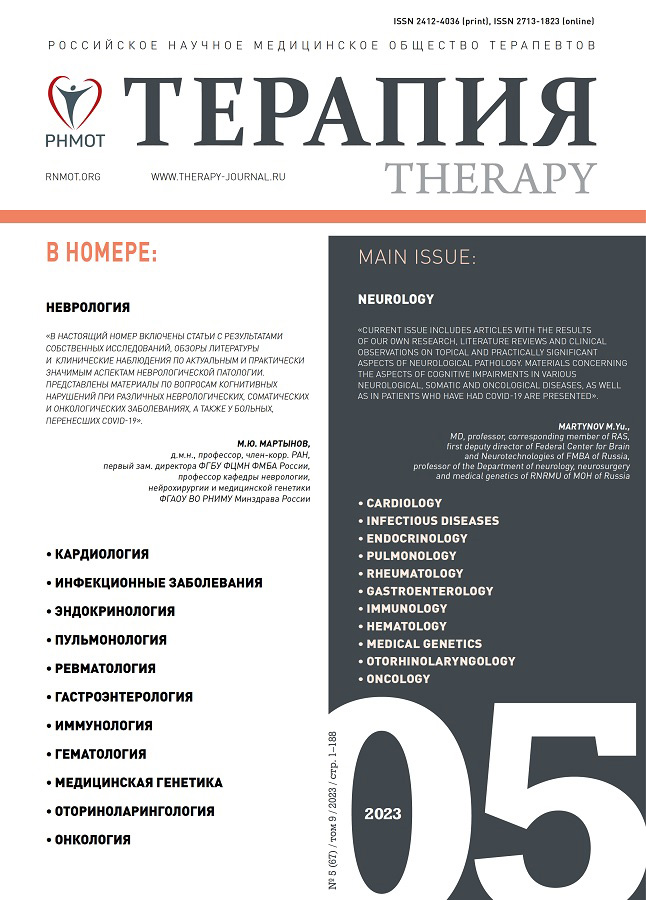Pain in the throat from the position of a practicing otolaryngologist: Advice justified by experience
- Autores: Savranskaya K.V.1, Miroshnichenko N.A.1, Bakotina A.V.1, Talalaev V.N.1
-
Afiliações:
- A.I. Yevdokimov Moscow State University of Medicine and Dentistry of the Ministry of Healthcare of Russia
- Edição: Volume 9, Nº 5 (2023)
- Páginas: 165-169
- Seção: ACTUAL ISSUES OF PHARMACOTHERAPY AND PREVENTIVE TREATMENT
- URL: https://journals.eco-vector.com/2412-4036/article/view/569132
- DOI: https://doi.org/10.18565/therapy.2023.5.165–169
- ID: 569132
Citar
Texto integral
Resumo
Sore throat is one of the most common complaints for which patients apply the doctor. Such patients could be observed by doctors of different specialties: pediatricians, therapists, otorhinolaryngologists and even dentists. There are very many reasons for a sore throat. Clinician should identify patients who require systemic antibiotic therapy and avoid unnecessary and potentially harmful treatment by opting for topical remedies. An important role in the treatment of infectious diseases of the throat and larynx is played by drugs containing lysozyme, including in complex clinical cases associated with the formation of microbial biofilms.
Texto integral
Sobre autores
Kristina Savranskaya
A.I. Yevdokimov Moscow State University of Medicine and Dentistry of the Ministry of Healthcare of Russia
Autor responsável pela correspondência
Email: kristina.savranskaya@gmail.com
ORCID ID: 0000-0001-8510-3719
PhD in Medical Sciences, Assistant at the Department of Otorhinolaryngology
Rússia, MoscowNina Miroshnichenko
A.I. Yevdokimov Moscow State University of Medicine and Dentistry of the Ministry of Healthcare of Russia
Email: mirnino@yandex.ru
MD, Associate Professor, Professor of the Department of Otorhinolaryngology
Rússia, MoscowAnna Bakotina
A.I. Yevdokimov Moscow State University of Medicine and Dentistry of the Ministry of Healthcare of Russia
Email: bakotina88@gmail.com
PhD in Medical Sciences, Assistant of the Department of Otorhinolaryngology
Rússia, MoscowVladimir Talalaev
A.I. Yevdokimov Moscow State University of Medicine and Dentistry of the Ministry of Healthcare of Russia
Email: 6113662@gmail.com
MD, Professor of the Department of Otorhinolaryngology
Rússia, MoscowBibliografia
- Абаджиди М.А., Молодцов С.А., Ашкинази В.И., Салина Е.В. Микрофлора буккального эпителия у детей, часто болеющих респираторными инфекциями. Российский педиатрический журнал. 2002; (1): 56–58. [Abadzhidi M.A., Molodtsov S.A., Ashkinazi V.I., Salina E.V. Microflora of the buccal epithelium in children with frequent respiratory infections. Rossiyskiy pediatricheskiy zhurnal = Russian Pediatric Journal. 2002; (1): 56–58 (In Russ.)].
- Овчинников А.Ю., Мирошниченко Н.А Екатеринчев В.А. Современные подходы к лечению боли в горле. Медицинский совет. 2020; (6): 31–34. [Ovchinnikov A.Yu., Mirochnichenko N.A., Ekaterinchev V.A. Modern approaches to the treatment of sore throat. Meditsinskiy sovet = Medical Council. 2020; (6): 31–34 (In Russ.)]. https://dx.doi.org/10.21518/2079-701X-2020-6-31-34. EDN: JHCVUC.
- Андреева И.В., Стецюк О.У., Азовскова О.В., Козлов Р.С. Терапия острого тонзиллофарингита: современные рекомендации и российские особенности. Клиническая микробиология и антимикробная химиотерапия. 2013; 15(3): 198–211. [Andreeva I.V., Stetsiouk O.U., Azovskova O.V., Kozlov R.S. Treatment of acute tonsillitis/pharyngitis: Current guidelines and Russian local situation. Klinicheskaya mikrobiologiya i antimikrobnaya khimioterapiya = Clinical Microbiology and Antimicrobial Chemotherapy. 2013; 15(3): 198–211 (In Russ.)]. EDN: RAWCSZ.
- Гуров А.В., Юшкина М.А., Мужичкова А.В. Микробиоценоз-регулирующая терапия воспалительной патологии ротоглотки. Вестник оториноларингологии. 2021; 86(6): 51–56. [Gurov A.V., Yushkina M.A., Muzhichkova A.V. Microbiocenosis-regulating therapy of inflammatory pathology of the oropharynx. Vestnik otorinolaringologii = Bulletin of Otorhinolaryngology. 2021; 86(6): 51–56 (In Russ.)]. https://dx.doi.org/10.17116/otorino20218606151. EDN: HMFFDL.
- Артюшкин С.А., Еремина Н.В. Естественные факторы защиты в лечении воспалительных заболеваний глотки и лимфаденоидного глоточного кольца. Медицинский совет. 2017; (16): 33–37. [Artyushkin S.A., Eremina N.V. Natural protective factors in therapy of inflammatory pharynx and lymphoid ring diseases. Meditsinskiy sovet = Medical Council. 2017; (16): 33–37 (In Russ.)]. https://dx.doi.org/10.21518/2079-701X-2017-16-33-37. EDN: ZRDSPL.
- Клинические рекомендации. Острый тонзиллит и фарингит (острый тонзиллофарингит). Национальная медицинская ассоциация оториноларингологов, Межрегиональная общественная организация «Альянс клинических химиотерапевтов и микробиологов», Союз педиатров России, Межрегиональная ассоциация по клинической микробиологии и антимикробной химиотерапии, Международная общественная организация «Евро-Азиатское общество по инфекционным болезням». Рубрикатор клинических рекомендаций Минздрава России. 2021. ID: 306. Доступ: https://cr.minzdrav.gov.ru/schema/306_2 (дата обращения – 01.06.2023). [Clinical guidelines. Acute tonsillitis and pharyngitis (acute tonsillopharyngitis). National Medical Association of Otorhinolaryngologists, Alliance of Clinical Chemotherapists and Microbiologists, Union of Pediatricians of Russia, Interregional Association for Clinical Microbiology and Antimicrobial Chemotherapy, Euro-Asian Society for Infectious Diseases. Rubricator of clinical guidelines of the Ministry of Healthcare of Russia. 2021. ID: 306. URL: https:// cr.minzdrav.gov.ru/schema/306_2 (date of access – 01.06.2022) (In Russ.)].
- Li S., Yue J., Dong B.R. et al. Acetaminophen (paracetamol) for the common cold in adults. Cochrane Database Syst Rev. 2013; 2013(7): CD008800. https://dx.doi.org/10.1002/14651858.CD008800.pub2.
- Costelloe C., Metcalfe C., Lovering A. et al. Effect of antibiotic prescribing in primary care on antimicrobial resistance in individual patients: Systematic review and meta-analysis. BMJ. 2010; 340: c2096. https://dx.doi.org/10.1136/bmj.c2096.
- Donlan R.M., Costerton J.W. Biofilms: Survival mechanisms of clinically relevant microorganisms. Clin Microbiol Rev. 2002; 15(2): 167–93. https://dx.doi.org/10.1128/CMR.15.2.167-193.2002.
- Landini P., Antoniani D., Burgess J.G., Nijland R. Molecular mechanisms of compounds affecting bacterial biofilm formation and dispersal. Appl Microbiol Biotechnol. 2010; 86(3): 813–23. https://dx.doi.org/10.1007/s00253-010-2468-8.
- Hentzer M., Givskov M. Pharmacological inhibition of quorum sensing for the treatment of chronic bacterial infections. J Clin Invest. 2003; 112(9): 1300–7. https://dx.doi.org/10.1172/JCI20074.
- Hall-Stoodley L., Costerton J.W., Stoodley P. Bacterial biofilms: From the natural environment to infectious diseases. Nat Rev Microbiol. 2004; 2(2): 95–108. https://dx.doi.org/10.1038/nrmicro821.
- Abu Bakar M., McKimm J., Haque S.Z. et al. Chronic tonsillitis and biofilms: A brief overview of treatment modalities. J Inflamm Res. 2018; 11: 329–37. https://dx.doi.org/10.2147/JIR.S162486. Erratum in: J Inflamm Res. 2018; 11: 375.
- Marquis G., Garzon S., Strykowski H., Auger P. Cell walls of normal and lysozyme-damaged blastoconidia of Candida albicans: Localization of surface factor 4 antigen and vicinal-glycol staining. Infect Immun. 1991; 59(4): 1312–18. https://dx.doi.org/10.1128/iai.59.4.1312-1318.1991.
- Калюжин О.В. Антибактериальные, противогрибковые, противовирусные и иммуномодулирующие эффекты лизоцима: от механизмов к фармакологическому применению. Эффективная фармакотерапия. 2018; (14): 6–13. [Kalyuzhin O.V. Antibacterial, antifungal, antiviral and immunomodulatory effects of lysozyme: from mechanisms to pharmacological application. Effektivnaya farmakoterapiya = Effective Pharmacotherapy. 2018; (14): 6–13 (In Russ.)]. EDN: UUCTTK.
- Ibrahim H.R., Thomas U., Pellegrini A. A helix-loop-helix peptide at the upper lip of the active site cleft of lysozyme confers potent antimicrobial activity with membrane permeabilization action. J Biol Chem. 2001; 276(47): 43767–74. https://dx.doi.org/10.1074/jbc.M106317200.
Arquivos suplementares








